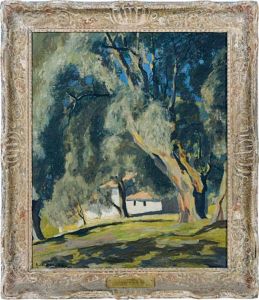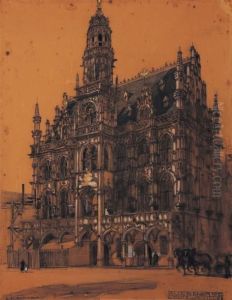Louis Hippolyte Boileau Paintings
Louis Hippolyte Boileau was a French architect known primarily for his work in the early 20th century, particularly in the Art Deco movement. Born on May 5, 1878, in Paris, France, Boileau was part of a family with a long tradition in architecture. His father, Louis-Charles Boileau, and grandfather, Louis-Auguste Boileau, were both architects, and this lineage provided him with a rich architectural heritage and a strong foundation for his future career.
Boileau studied at the École des Beaux-Arts in Paris, which was the premier architecture school in France, and was pivotal in shaping the style and philosophy of the architects of his generation. After completing his studies, Boileau worked on a variety of projects, including commercial buildings, apartment buildings, and exhibition pavilions. He collaborated with other architects and designers of the time, contributing to the architectural landscape of Paris and other French cities.
He was particularly noted for his collaboration with the furniture designer Louis Süe on the construction of the La Maison Cubiste, which was exhibited at the Salon d'Automne in 1912. This project was influential in the development of the Cubist movement in architecture. Boileau's work was characterized by a blend of traditional French architectural styles with the modernist movements that were gaining momentum during his career, such as Art Deco and later, the International Style.
One of Boileau's most significant contributions to architecture was his involvement in the design and construction of several department stores in Paris, which were among the first to incorporate steel framing and glass on such a large scale. His design approach for these projects was both functional and aesthetically pleasing, aligning with the Art Deco movement's emphasis on sleek lines and ornamentation.
Throughout his career, Boileau also engaged in urban planning and was a proponent of improving living conditions in urban areas through thoughtful design. His ideas contributed to the development of modern urbanism in France.
Boileau's influence extended beyond his own projects. He was an active member of the Société des Architectes Diplômés par le Gouvernement (SADG), which played a key role in defining professional standards for architects in France. Boileau's work was recognized in his lifetime, and he was awarded the title of Chevalier of the Legion of Honour for his contributions to French architecture.
Louis Hippolyte Boileau passed away on October 28, 1948, leaving behind a legacy of architectural innovation that blended traditional French styles with the emerging modernist trends of the early 20th century. His work remains a testament to the transitional period in architecture, where the ornamental and the functional began to merge in new and exciting ways.

